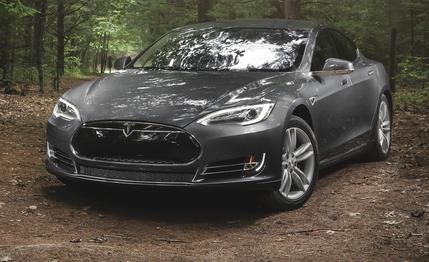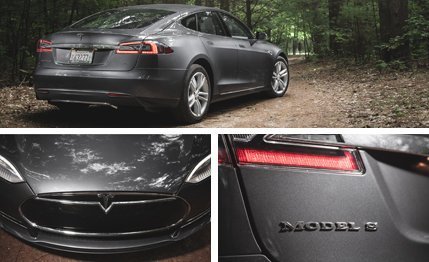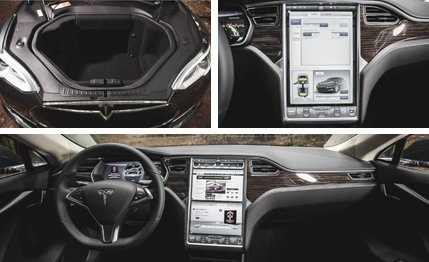 Instrumented Test
Instrumented Test
The future does not seem so amazing here, parked behind a grocery store in suburban Toledo, Ohio. It is raining, and without a canopy of protective solar panels over this particular Tesla Supercharger station, the one closest to our Ann Arbor, Michigan, office, we are resigned to sitting in the car while it replenishes its battery. Were it not for the Model S’s navigation system, part of the $3750 Tech package, we would never have found the location. No signs on the main road direct drivers this way, no structure identifies this solitary bank of six DC chargers as anything at all. Small, red placards like those that decorate parking garages proclaim, “Tesla Electric Vehicle Parking,” but that’s the extent of any notice that this spot is, in fact, part of something much larger.
Tesla’s network of 125 Superchargers now spans across the United States and up and down the coasts. Although it has yet to achieve the sort of density by which spontaneous travel can be undertaken, at least not without relying on the public charging marketplace, the company is also not finished. (Additionally, Tesla has been assisting in the installation of 240-volt AC “High Power Wall Connectors” in well-traveled locales around the country, but these charge at a much slower rate.)
Unlike filling a gas tank, charging the battery of an electric car is not a linear process and slows as the battery gets closer to full. So Tesla quotes a 20-minute charge time to replenish the Model S battery to half its capacity using one of the 120-kW Superchargers. This is about 16 times as fast as most public charging stations, according to the company. Sitting in the Model S watching the miles pile up in the range indicator just as steadily as the precipitation comes down outside, the claim is believable. A 35-minute respite added 100 miles of range before we motored back to the office.
The Model S takes a proprietary connector, for which the company provides a variety of adapters including one for a standard SAE J1772 plug like on the Chevy Volt and other EVs, a 120-volt wall plug, and even the receptacle for a 240-volt electric clothes dryer. This means Model S owners can charge pretty much anywhere, but others are not so lucky. The special Tesla connector locks out other EVs from using the Tesla network, so even cars like the Nissan Leaf, which supports DC charging, cannot use Superchargers.

Every Model S includes the necessary wiring for DC charging, which bypasses the onboard 10-kW charger, although not every Model S can actually use a Supercharger. Vehicles with the 85-kWh battery have access included in their $81,070 base price, however 60-kWh cars do not. This is one way Tesla can cut the base price of the 60-kWh car to $71,070. Supercharging is offered as an additional $2000 option, a fee that goes up to $2500 if it’s added after delivery.
While local electricity rates vary, we’ll make the observation that $2000 buys a lot of juice. But what you’re paying for is not really the electrons as much as the convenience. There is currently no way to purchase temporary access or any pay-as-you-go plan. Tesla has, however, promised “free” lifetime charging at Superchargers, a guarantee as enticing as it is likely to wind up in a class action at some future date, especially given the presumably high percentage of Tesla drivers who are members of the State Bar of California.
There are other differences between the models, the most important being range. When we tested the top-of-the-line Signature Performance (P85) Model S in 2012, we managed to drive 211 miles on a completely charged battery. This 60-kWh car did 164 miles. While that’s below the official EPA range estimate of 208 miles, it’s only 22-percent less than the P85’s figure. Certainly the lower output of the 302-hp (225-kW) motor in our 2014 test car helped its range, as did a curb weight of 4323 pounds. The P85 has 416 horses, but on our scales it weighed an additional 462 pounds. As you’d expect, this lighter, less powerful model proves more efficient: Using the EPA’s standard, the 60 rates 94 MPGe city and 97 highway while the P85 comes in at 88/90. In our hands, this car got 87 MPGe versus the 74 we observed in the top model.
Our 60-kWh example also came close to matching the P85’s track performance. We clocked it at 5.5 seconds to 60 mph on the way to a 14.2-second quarter-mile pass. The P85 was 0.9-second quicker in both measures. With the stock 19-inch, all-season rubber and standard suspension, the 60 pulled 0.89 g on the skidpad, whereas the P85’s upgraded air suspension and 21-inch wheels shod with Michelin Pilot Sports was good for 0.91. Stopping distance from 70 mph, however, increased from 160 feet in the P85 to 174 in the 60.

While we don’t like to issue caveats about test-track results, we will say that Tesla has issued software upgrades in the two years since we tested the P85, some of which have addressed throttle response and suspension tuning.
Comparisons among versions of the Model S are rather beside the point: The real issue is whether the Model S is an acceptable alternative to conventional luxury cars. The answer is an unqualified “yes.” Aesthetically, the Model S is a class leader, its exterior shape appearing as fresh today as it did when the prototype was first shown in 2009. The interior is both attractive and well executed, with quality finishes and tight tolerances.
Even the base Model S without the air suspension rides comfortably and delivers supple and predictable handling. The steering is more distant and isolated than we might like, but that’s not uncommon in this class. Driving the Model S is proof that there are different ways to have fun behind the wheel. The one-pedal approach, using the car’s high level of regenerative braking instead of the mechanical brakes, requires a different driving style but rewards a useful skill like situational awareness.
Buying a Tesla means making specific compromises and sacrifices, and they’re different from the compromises and sacrifices other vehicles demand. Yes, “range anxiety” is still a thing, but so is the electric-car revolution if you know where to look. A lack of architecture in northern Ohio may be allowing it to remain unnoticed, just as our gray Tesla Model S glided silently through Midwestern traffic without drawing attention, but some 250,000 plug-in vehicles have been sold in the U.S. in the last three-and-a-half years. Yes, some of those are California specials, EV projects of dubious profitability rigged up by manufacturers to satisfy CARB. And others are hybrids with cords, Toyota Priuses and the like, cars still largely dependent on the petroleum infrastructure. But sitting atop the heap is the Tesla Model S, which is not only the best electron-powered chariot you can buy but the only one offering up its own exclusive ecosystem.